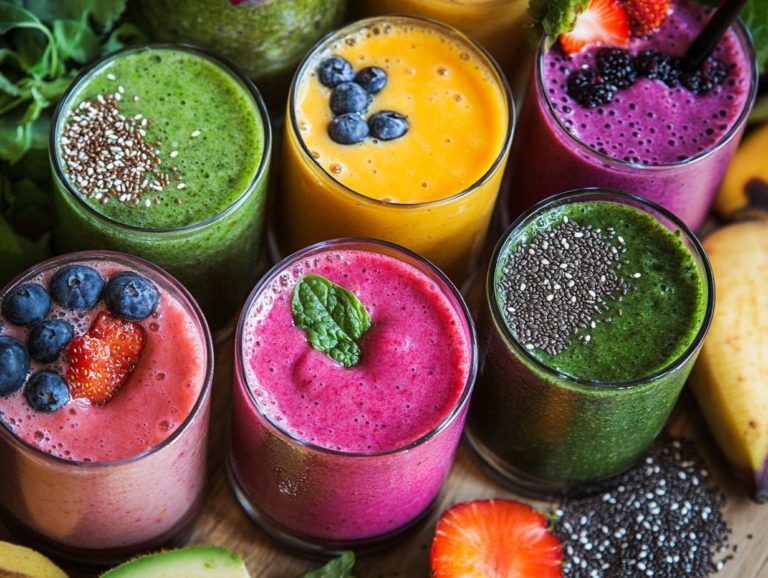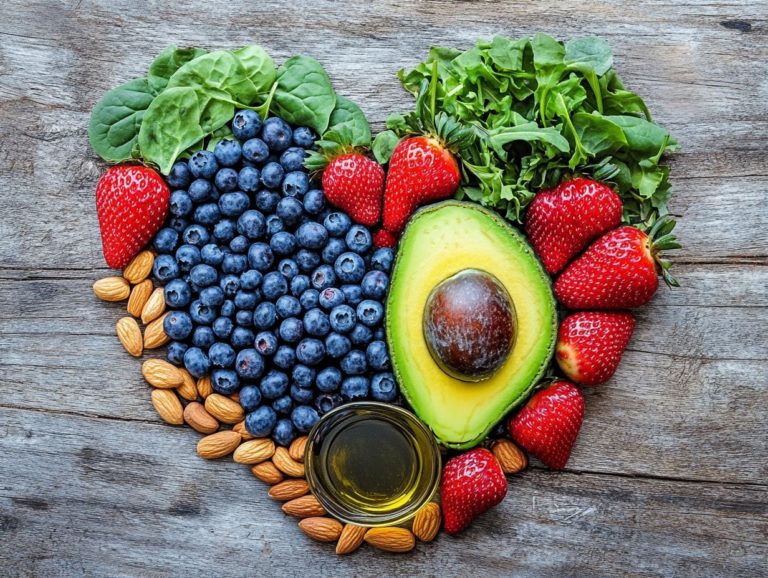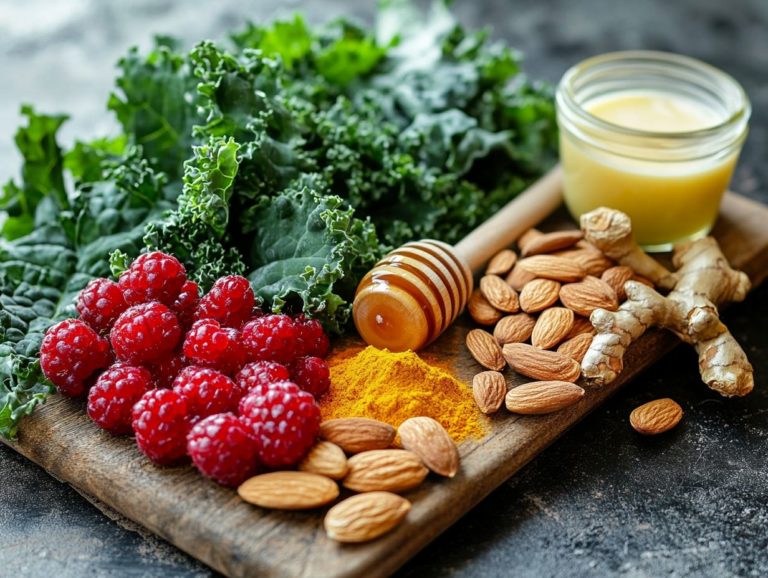Why Quinoa is a Nutritional Powerhouse
Quinoa, often celebrated as a superfood, has undoubtedly carved out a remarkable niche in the culinary world, thanks to its exceptional nutritional profile and versatility in the kitchen.
This ancient grain, hailing from the Andean regions of South America, is a treasure trove of macronutrients, brimming with essential vitamins and minerals. You ll find that quinoa offers a myriad of impressive health benefits everything from boosting heart health to enhancing digestion.
In this exploration, you ll uncover delectable recipe ideas alongside expert tips for selecting and storing this nutritional powerhouse.
Embrace the journey and discover why quinoa truly deserves a prominent place on your plate!
Contents
Key Takeaways:
- Quinoa is a highly nutritious grain that is rich in both macronutrients and micronutrients, making it a great addition to any diet.
- Regular consumption of quinoa can help improve heart health, manage blood sugar levels, and boost digestive health due to its high fiber and antioxidant content.
- With its versatile and delicious flavor, quinoa can easily be incorporated into a variety of dishes, making it a convenient and healthy option for any meal.
History and Origin
The rich history and origin of quinoa stretch back thousands of years to the Inca people of South America, who recognized its potential as a staple food, often referring to it as the ‘mother grain.’
This nutrient-dense grain-like seed has experienced a remarkable resurgence in the United States, where it is celebrated for its gluten-free properties and impressive health benefits, including high protein content and essential amino acids, which are the building blocks that your body cannot produce on its own.
Cultivated in the rugged Andes mountains, quinoa was not just a vital food source; it also held significant cultural importance, often being incorporated into religious ceremonies and traditional celebrations.
As its popularity soared globally, particularly in the United States over the past two decades, quinoa transformed from a local staple into a trendy superfood, embraced across various culinary creations.
This journey encapsulates a harmonious blend of ancient tradition and modern dietary needs, showcasing quinoa’s remarkable adaptability and enduring legacy as a nourishing component of both past and contemporary diets.
Nutritional Profile of Quinoa
Quinoa presents an exceptional nutritional profile, making it a highly regarded option for those who prioritize their health. Not only is it gluten-free, but it s also rich in protein, offering essential amino acids that your body craves.
Quinoa also serves as an excellent source of dietary fiber, magnesium, and folate. This ensures you receive a well-rounded boost in your daily nutrition.
Macronutrient and Micronutrient Content
Quinoa s macronutrient profile is a champion of balance, rich in protein and dietary fiber, making it an ideal choice for those seeking a plant-based alternative in their meals. Its micronutrients, such as magnesium and folate, only add to its allure.
In fact, you ll find that quinoa packs about 8 grams of protein per cooked cup considerably more than many other grains like rice or barley. It also features a healthy fat content, predominantly unsaturated fats, which are great for heart health.
The complex carbohydrates in quinoa offer sustained energy, making it a superb option for athletes and active individuals. When you stack quinoa against other grains, it truly shines with an impressive array of vitamins and minerals.
This includes iron, which plays a crucial role in oxygen transport in the blood, and potassium, essential for maintaining healthy blood pressure levels. By incorporating quinoa into your diet, you can reap a variety of nutritional benefits that bolster your overall health.
Health Benefits of Quinoa
Don’t miss out on the remarkable health benefits of quinoa! It not only promotes cardiovascular health with its impressive antioxidant properties but also assists in regulating blood sugar levels.
Additionally, its abundant fiber content plays a significant role in enhancing digestive health.
Conclusion
Incorporating quinoa into your daily meals is a simple yet impactful way to enhance your nutrition. Its rich profile offers a variety of health benefits, making it a versatile and essential addition to any diet.
Improving Heart Health
Incorporating quinoa into your diet can greatly enhance your heart health, thanks to its impressive levels of antioxidants and magnesium two key players in maintaining a robust cardiovascular system.
Recent studies indicate that diets rich in magnesium are effective in lowering blood pressure and reducing the risk of heart disease. The antioxidants in quinoa work to combat oxidative stress, further supporting your heart’s well-being.
To fully harness these benefits, consider weaving quinoa into your meals. Use it as a base for a vibrant salad, combining it with fresh vegetables and a light vinaigrette, or stir it into soups for added texture and nutrition.
When you pair quinoa with beans or lentils, you enhance its protein profile, making it a smart, heart-healthy choice for your weekly meal prep.
Managing Blood Sugar Levels
Quinoa’s low glycemic index a measure of how quickly foods raise blood sugar levels and high dietary fiber content position it as an exceptional choice for managing blood sugar levels. It delivers a steady energy release without causing those pesky spikes in glucose.
This unique quality distinguishes quinoa from other grains like white rice or even wheat, which can trigger rapid increases in blood sugar. Packed with essential amino acids, quinoa is a complete protein, setting it apart from many traditional grains that often lack certain amino acids.
This impressive nutritional profile not only promotes satiety but also aids in stabilizing blood sugar levels over time. By incorporating quinoa into your meals, you can effectively manage hunger and energy levels, ultimately fostering a healthier lifestyle tailored for diabetes management.
Boosting Digestive Health
The high dietary fiber content of quinoa is your ally in promoting digestive health. It encourages regular bowel movements and cultivates a thriving gut environment, making it a stellar addition to your balanced diet.
This ancient grain enhances digestion and delivers essential nutrients that aid in breaking down food more efficiently. By incorporating quinoa into your meals, you can tackle issues like constipation and bloating, leading to a more comfortable digestive experience.
For optimal health benefits, rinse your quinoa thoroughly to remove saponins, which can give a bitter taste. Aim for a 2:1 water-to-quinoa ratio while cooking to achieve that perfect fluffy texture. Don’t overlook the greens of the quinoa plant packed with vitamins and minerals, they can elevate your salads and smoothies, offering a nutritious powerhouse of fiber that supports overall gut health.
Incorporating Quinoa into Your Diet
Incorporating quinoa into your diet is simple and remarkably versatile. You can easily use it in a variety of dishes, from vibrant quinoa salads to comforting quinoa porridge, or even as a nutritious base for your meal prep.
Get ready to explore endless cooking possibilities with quinoa! This opens up a world of cooking ideas, inviting you to experiment and explore countless flavor combinations.
Recipe Ideas and Tips
Exploring quinoa recipes opens up a world of culinary possibilities, from refreshing quinoa salads and hearty porridge to innovative quinoa biscuits that can elevate any meal.
This ancient grain serves not only as a protein-packed base but also pairs beautifully with various ingredients. Imagine tossing quinoa with roasted vegetables and a zesty lemon vinaigrette for a vibrant side dish, or blending it into a smoothie for a nutritious breakfast boost.
Experimenting with different cooking methods can also add flair to your dishes. Try toasting the seeds before boiling them to enhance their nutty flavor, or opt for vegetable broth instead of water for a delightful umami kick. Don t hesitate to add spices, herbs, or even fruits to craft a unique flavor profile that perfectly suits your taste.
Buying and Storing Quinoa
When selecting quinoa, it s crucial to choose a high-quality variety and familiarize yourself with effective storage techniques. Choosing high-quality quinoa now ensures you get the most nutrition and flavor in your meals!
This will not only preserve its freshness but also maintain its nutritional integrity, allowing you to fully enjoy the benefits of this superfood.
Choosing Quality Quinoa
Choosing quality quinoa is crucial! It means recognizing the various quinoa varieties and understanding key factors, such as the presence of saponins natural compounds that can give quinoa a bitter taste if not rinsed away all while ensuring your selection is gluten-free.
To select the best quinoa, look for grains that are plump and shiny, free from any discoloration or debris. High-quality quinoa often boasts a consistent color and texture, indicating its freshness. When cooked, it should deliver a delightful, slightly nutty flavor that many find appealing, showcasing its versatility across a multitude of dishes.
Rinsing quinoa thoroughly before cooking is essential; this step helps eliminate the bitter saponins that may linger on the grain’s surface. By taking the time to rinse, you not only enhance the flavor but also elevate the overall enjoyment of your dish significantly.
Proper Storage Techniques
Proper storage techniques for quinoa are essential to preserving its nutritional benefits and extending its shelf life. By keeping it in a cool, dry place, you’ll help maintain its flavor and prevent spoilage.
Avoid moisture and heat by using airtight containers to provide an extra layer of protection against air exposure and contaminants. If you’re buying in bulk, vacuum-sealed bags are a fantastic choice; they can significantly extend your quinoa’s shelf life, often up to two to three years when stored properly.
When preparing quinoa, rinsing it before cooking not only eliminates any residual bitterness but also enhances its overall taste, ensuring that each meal is delicious. Always inspect the grains for any signs of spoilage, such as discoloration or an off smell, as these could indicate that your quinoa has lost its freshness.
Frequently Asked Questions
Curious about quinoa? Here are some common questions answered!
What makes quinoa a nutritional powerhouse?
Quinoa is considered a nutritional powerhouse because it is packed with a variety of essential vitamins, minerals, and nutrients that are necessary for optimal health and well-being.
How does quinoa compare to other grains?
Unlike other grains, quinoa is a complete protein source, meaning it contains all nine essential amino acids that our bodies cannot produce on their own. It also has a higher protein and nutrient content compared to other grains.
Is quinoa suitable for a gluten-free diet?
Yes, quinoa is naturally gluten-free, making it a great alternative for those with gluten sensitivities or celiac disease. However, it is important to check the label on pre-packaged quinoa products to ensure they have not been cross-contaminated with gluten-containing grains during processing.
How can quinoa benefit my overall health?
Quinoa is a rich source of antioxidants, which can help boost your immune system and protect against chronic diseases. It also contains high amounts of fiber, which can aid in digestion and promote heart health.
How can I incorporate quinoa into my diet?
Quinoa is a versatile ingredient that can be used in a variety of dishes, such as salads, stir-fries, and even as a substitute for rice or pasta. It can also be ground into flour and used in baking recipes.
Is quinoa suitable for everyone?
Quinoa is generally safe for everyone to consume, but it is always best to consult with a healthcare professional before making any significant changes to your diet. Additionally, those with allergies to quinoa or other similar foods should avoid consuming it.
Ready to try quinoa? Start exploring its delicious possibilities today!





